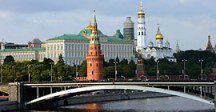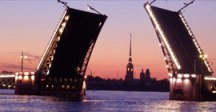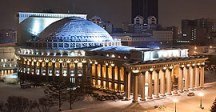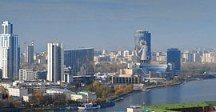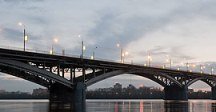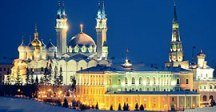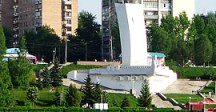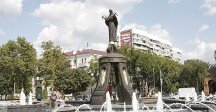Map of Kostroma
Detailed interactive map of Kostroma. Map of Kostroma with streets and numbers of houses. Satellite map of Kostroma with sights of the city.
The change between the satellite map of Kostroma and the schematic one is made in the lower left corner of the interactive map.
Kostroma
Population of Kostroma: 277,393 people (2021)
Date of foundation of Kostroma: 1152.
Kostroma city phone code: +7 4942
Kostroma city car code: 44
Postal code of the city Kostroma: 156xxx
Kostroma is a Russian port city located on the Volga River. Being one of the most beautiful historical cities in the country, it is included in the Golden Ring. It is believed that the founding date of the city was 1152, although the first settlements have been known since the 9th century.
Modern Kostroma has managed to preserve its magnificent architectural and historical heritage, carrying it through the centuries. The most famous sights of the city include the Epiphany Monastery, the Church of the Resurrection on the Debra, the Ipatievsky Monastery, the Church of the Savior in the Ranks, as well as the old Kostroma streets with ancient buildings that have been preserved since the time of Empress Catherine. In addition to religious buildings, buildings of 19th-century civil architecture add color to the appearance.
What to see in Kostroma
Borshchov's mansion. The elegant classical-style mansion, located on Susanin Square, is known as the Borshchov Mansion in honor of its owner, Lieutenant General Sergei Borshchov, who built it in 1824 after his discharge from the army.
Fire Watchtower on Simanovsky Street. One of the main symbols of Kostroma is its Fire Watchtower. It was built between 1824 and 1827 both to protect the city from fire and to become a tourist attraction. Restoration work was carried out in the middle of the 20th century, and its octagonal watchtower was restored to its former splendor.
The art gallery "Fish rows" on Molochnaya Gora Street. The fish rows were built in the middle of the 19th century as part of the shopping malls surrounding Susanin Square. As their name implies, these rows were designed specifically for the sale of fish. In 2010, the building of the Fish Rows was transferred to the Kostroma Historical, Architectural and Art Museum-Reserve.
Monument to Ivan Susanin on Susaninskaya Square. This monument to the man who is credited with saving the life of Mikhail Romanov from the Polish invaders, which was opened in 1967. The early monument to Ivan Susanin was created in 1851 by order of Emperor Nicholas I. This monument depicted a bust of Tsar Mikhail on a column, at the base of which stood Susanin.
The Military History Museum on Lenin Street. Next to the Fire Watchtower is a Military prison, built around the same time as the Watchtower, between 1823 and 1826. Now there is a Military History Museum and exhibits dedicated to the Russian Army for centuries are on display here.
The building of the Noble Assembly dates back to the middle of the 19th century and was built in the classical style. Today, the building is part of the Kostroma Historical, Architectural and Art Museum-Reserve, and exhibitions dedicated to Kostroma and the life of its nobility in the 19th century are held here. In addition, temporary exhibitions and presentations are also held here.
Monument to Prince Yuri Dolgoruky. Historian Vasily Tatishchev attributed the foundation of Kostroma to Prince Yuri Dolgoruky, and then to the Grand Duke of Kiev. Dolgoruky is known for founding many other Russian cities, including Moscow. The monument was opened in 2003 for the 850th anniversary of the city.
The Romanov Museum was opened in 1913 by Emperor Nicholas II during his visit to Kostroma. The museum is located in a beautiful two-storey building, specially designed for use as a museum. Today, the museum tells in detail about the history of the Kostroma region and its people, paying special attention to the Romanov and Godunov dynasties, which are related to Kostroma. The museum is under the jurisdiction of the Kostroma Historical, Architectural and Art Museum-Reserve.
The monument to Lenin in Kostroma is interesting because it stands on a massive pedestal, which was originally destined to become the foundation of a grandiose monument to the 300th anniversary of the House of Romanov.
By the revolution, only the pedestal was completed, although it was assumed that it would include 26 figures of people associated with the Romanov rule. Shortly after Lenin's death in 1924, it was decided to erect a statue of him instead.
The Epiphany-Anastasian Monastery was founded as the Epiphany Monastery by St. Nikita of Kostroma, a disciple of St. Sergius of Radonezh. In 1565, the first stone cathedral of the monastery was built.
The miraculous Image of the Church of the Savior is located in that part of Kostroma, which is historically known as Zaprudnaya. It was built in 1754 in the classical style, presumably on the spot where the icon of Our Lady of St. Theodore reappeared. Once a year, processions with an icon were made from the Assumption Cathedral to this church.
The Church of St. Alexius was built between 1759 and 1762 in the form of a two-storey yellow building with one green dome. There is a round bell tower on the facade of this building.
The Church of St. John Chrysostom was built in 1751 to replace an earlier version built with donations from Tsar Michael. In shape, it has a tall main building with five elongated silver domes. This church remained open throughout the Soviet era.
A war memorial on Peace Square dedicated to the heroism shown by the Soviet people during World War II.
The Znamensky Convent was founded in 1993 around the previously existing Church of the Resurrection of Christ of the 17th century and the Church of the Sign of the Blessed Virgin Mary of the early 19th century. The Church of the Resurrection of Christ is one of the most beautiful churches in Kostroma and was built between 1645 and 1652.
Ipatievsky Monastery on the street of Enlightenment. The first mention of the Ipatiev Monastery appeared in 1432, when Vasily II Russian signed a peace treaty with Vasily Kosy here. One legend says that it was founded around 1330 by a Tatar nobleman named Chet, who entered the service of Ivan Kalita and converted to Christianity.
Just outside the walls of the Ipatievsky Monastery there is the Kostroma Architectural, Ethnographic and Landscape Museum-reserve "Kostroma Sloboda" - an open-air museum of wooden architecture. There are many beautiful examples of wooden churches, houses, huts and baths inside.
Transport in Kostroma
Kostroma-Novaya Railway Station is located on the Forecourt, near the end of Sovetskaya Street and about 3.5 km from the city center. To get to the city center, take trolleybus No. 2 from the Shirokov Square bus stop, which is located next to the railway station, bus No. 7 or minibus No. 7 or No. 42. Station address: Privokzalnaya square, 2.
Popular destinations: St. Petersburg, Moscow, Rybinsk, Yaroslavl, Kirov, Perm, Tyumen, Omsk and other cities on the Trans-Siberian route. Commuter trains run in the direction of Yaroslavl and Galich.
Kostroma Bus Station is about 1 km away. east of Kostroma railway station on Kineshemskoye highway. To get there from the train station, cross the bridge and walk along the highway. The address of the bus station:Kineshemskoe highway, 21.
Popular destinations: Galich, Nerekhta, Sudislavl, Moscow, Ivanovo, Nizhny Novgorod, Vladimir, Vologda, Yaroslavl.
Kostroma Sokerkino Airport is located northeast of the city, about 7 km from Susaninskaya Square. Minibuses No. 5 and No. 13 run to the airport from Susaninskaya Square. Airport address: 120 Kostromskaya Street.
In addition to the standard long-distance trains connecting Moscow with Kostroma, there is also a branded Kostroma train. It departs from Yaroslavsky railway Station in Moscow and from Kostroma-Novaya Railway Station daily. About 7 buses a day run in both directions between the Moscow Shchelkovsky Bus Station and Kostroma Bus Station.
Sights of Kostroma
Susaninskaya Square, Guardhouse, Senator Borshchov's Mansion, Museum of Wooden Architecture, Museum of Flax and Birch bark, Snow Maiden's Terem, Epiphany-Anastasia Convent, Ipatievsky Monastery, Park on Nikitskaya, Zoo, Moose Farm, Planetarium, Jewelry Factory, Monument in honor of the 300th anniversary of the Romanov House, Fire tower, Monument to Ivan Susanin, Spaso-Preobrazhenskaya Church, Vlasyevskaya Church, Kostroma Regional Puppet Theater, Church of the Nativity on Gorodishche.
The largest cities in Russia:
2024 © Russia-Karta.ru
